|
This document explains how you pay for resold resources and services.
It complements the guides on billing
that explain how you charge your end customers.
How do I resell?
Reselling with Parallels H-Sphere doesn't accord one-to-one with the general concept of
reselling. You don't buy resources before selling them. You pay AFTER you sell.
When a customer signs up for your plan and gets an account, physical
resources are created, and the system charges him the fees you have set
up in the plan. At the same time, your parent host charges you at their
own prices. The difference between the resource price set by your parent
host (wholesale price) and the price you set (retail price) makes your
profit.
Currency Issues
You can resell hosting services in a currency which is different from
that of your parent hosting provider. This doesn't require currency
conversion. You pay dollars, and charge whatever you set in the
regional settings.
Wholesale Prices vs Retail Prices
There are two pages that tell you what you are going to be charged:
Online Price and Reseller Price. Online price tells you what your
provider charges you for your reseller account (CP Account),
reseller traffic, and summary disk usage. The In Use column shows
the summary disk usage limit and summary traffic limit you have set in
your reseller control panel. Reseller price tells you the prices
you will be charged for the resources purchased and used by your end
customers.
To open the Reseller price page, log into your reseller
account and go to Billing -> Reseller Price:
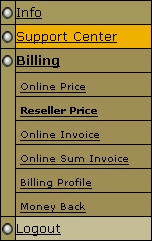
This will bring up a chart with the wholesale fees you will
be charged for resources created and used under your end customers'
accounts:
Table 1.

Units
- Free: the amount of resource units your parent host gives you
for free. In other words you can distribute them between your end-customers
and not be charged.
E.g.: with 5 free actual accounts you can create one reseller administrative
account, one account to host your own site, so called system account, and
not pay for it. Besides, you can distribute the rest 3 accounts among your
end-customers, either for free or as payable resource. In the latter case
all the money you charge your end customers for account creation will make
up your net profit, as you are not supposed to pay you parent host anything
for them. When you run out of the resources allocated as free, you will have
to pay your parent host the fee he set for each new account created by your
end-customers.
- In Use: the amount of resource units your end users are already
using. In case of quota resources such as Disk space Quota, this value shows
the total of all end user quotas regardless of actual disk usage.
- Max: the amount of resource units you are restricted to distribute at
most.
Fees
- Setup Fee: the amount of money you are charged single-time by your parent
host for creation of each payable resource unit under your end customer accounts.
- Recurrent Fee: the amount of money you are regularly charged by your
parent host as monthly payment for maintenance of each payable resource unit
created under your end-customer account.
- Usage Fee: not valid yet, reserved for future implementation.
- Refund Percentage: percentage of the recurrent fee to be returned
to you in case your end customer decides to quit hosting and get his money
back. This sum is adjusted to the time left to the end of the end-customer's
billing period and is calculated according to the formula:
money your parent host returns you = setup fee x days left
to the end of the billing period x refund percentage / billing
period duration in days / 100%.
E.g.: if your customer quits hosting on the 15th day from the beginning of
his 30 days billing period, with $7 setup fee and 50% refund, parent host
will return you $1,75 (=$7x15x50/30/100).
The example below shows how this works:
You created custom hosting plan "Bronze" and set
such prices for the resources included:
| Table 2. Prices you set for plan Bronze (retail
prices) |
| |
free |
setup |
monthly |
usage (extra) |
| Account |
0 |
$20 |
$8 |
N/A |
| Domain |
0 |
$2 |
$11 |
N/A |
| Webalizer |
0 |
$0 |
$4 |
N/A |
| Summary Traffic |
1 GB |
N/A |
$3 |
$5 |
A user comes to your site and signs up for this plan. As
soon as he is through with signup procedure with his domain
transferred:
| You charge your customer (see table
2) |
You are charged by your parent host (see
table 1) |
|
setup for account creation -
|
$20 |
setup for creation of your customer account - |
$5 |
| recurrent for account maintenance - |
$8 |
recurrent fee for maintenance of his account
- |
$7 |
| setup for domain transference - |
$2 |
setup for domain transference - |
$2 |
| recurrent for domain maintenance - |
$11 |
recurrent for domain maintenance - |
$10 |
| setup for creating Webalizer-
|
$0 |
setup for creating Webalizer
resource - |
$3 |
| recurrent for using Webalizer - |
$4 |
recurrent for using Webalizer - |
$1 |
| Then the user buys additional
2 GB of traffic because he doesn't want to pay you for
overlimiting $5 for each GB run up on his site. |
|
recurrent for traffic increase
|
$6 |
A |
if you haven't distributed and run out of 10 GB free
traffic you were restricted to by your parent host |
$0 |
|
B |
if you have distributed and run out of 10
GB free traffic you were restricted to by your parent
host |
$2 |
|
Total=
|
$51 |
Total=
|
$28 (A) or $30 (B) |
Use the following formula to calculate how much you finally
net:
Net money you make = money you charge your customers–
money you pay to your parent host.
$51 – $28 = $23 (for A case)
or
$51 – $30 = $21 (for B case)
How do I view my billing history?
To learn how much you were accrued and charged, go to Billing -> Online
Invoice or Online Sum Invoice. The latter allows you to view invoices for
all your billing profiles, in case you use different credit cards or billing
info for your checks (more about multiple billing profiles)on
the contrary to online invoice which shows invoices only for your active
billing profile you currently use:
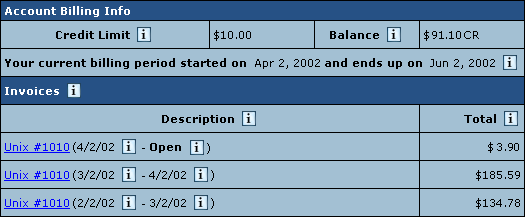
On the Invoice page you can learn you current billing period start and
end dates, what your credit limit and current balance are:
- Credit Limit restricts your ability to buy new resources in case
your credit card fails to be charged or you have run out of your balance money
if you pay by check.
- Balance shows how much money you have at your disposal. A negative
balance shows how much you owe for the services used. This is usually appropriate
for users who pay by check and for credit card users whose credit cards failed
to be charged.
- Description: your current account ID and plan. In brackets you are
shown when a billing period was opened and closed.
- Total: debit accruals + taxes drawn against your account during the
billing period. The amount isn't related to factual charges. And credits are
ignored in calculation of Total as well.
For example:
with - $2 opening balance and 10% tax you were accrued $10 setup fee + $1
tax. You then sent $20 check and account was charged $13, the Total will
show $11.00 (debit accrual + tax).
* The initial setup fee is put in a separate invoice.
To view details of any invoice in the billing history, click its ID link
in the Description column. The picture below illustrates details for an
invoice consisting of separate bills:
* find explanations below the entries/cells they apply to.
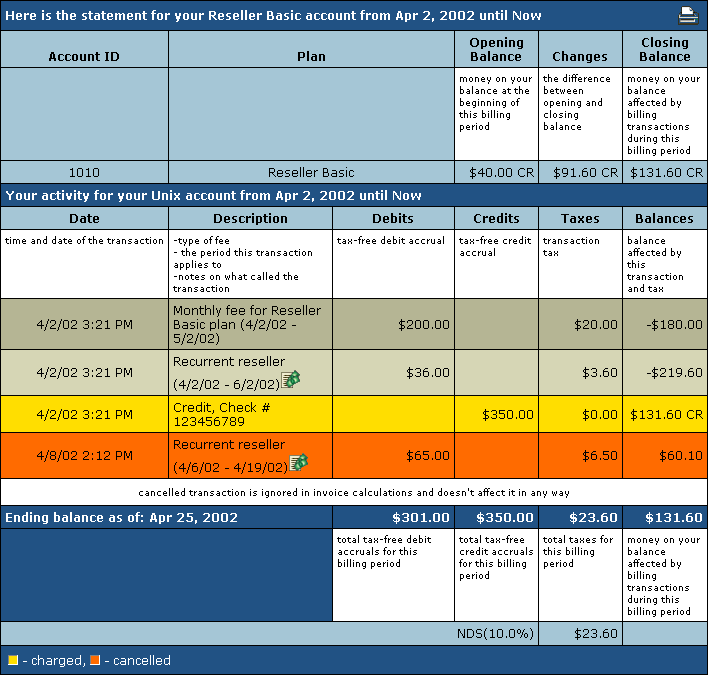
*Note: if by the end of the billing period you are accrued the amount
which doesn't exceed the credit limit, it isn't charged, but carried over to
the next billing period and included into the proceeding charge.
To see what makes your 'end customers' charges or accruals,
click the invoice icon in the description entry. This
will bring you to the page similar to the one below:
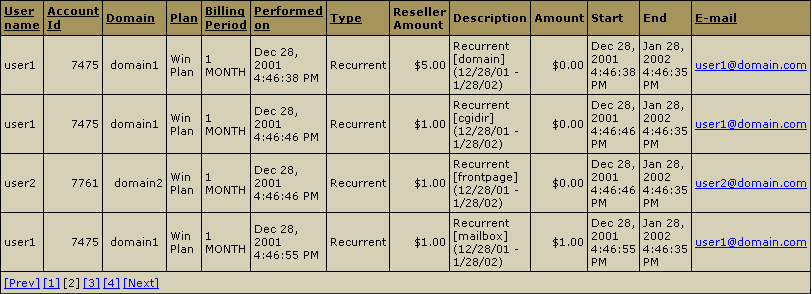
- Reseller Amount: the money that you charge or accrued
your end users as the fee defined in the Description
column.
- Description: what you charged your users for.
- Amount: the money that you were charged or accrued
by your parent host.
- Start/End: the dates when end customers' billing
periods started and end.
* Click the underlined column headers to sort the entries.
* Under the chart you can find navigation links.
How do I pay?
Your billing details, such as billing info (essential for
checks) and credit card info (valid only for credit card payment),
are stored in your billing profile.
- Billing Info comprises the details such as first
and second names, company name, phone, e-mail and address
you provided at the sign up aside from your contact info.
This is where the admin mails bills if you has chosen to
pay by check. This info is also used to contact the person
responsible for the financial aspects of your account.
- Credit Card Info comprises the number, name and
expiration date of user's credit card.
Having multiple billing profiles gives you an opportunity to use several check
accounts or credit cards in turn, activating the one you currently would like
to be used. Also, you can share one billing profile between your accounts. This
means you can pay with one card / receive bills at one address for all your
accounts. Settings are configured individually for each billing profile.
To create a new billing profile or view the settings of the
existing profiles, select Billing Profile in the Billing
menu. You would be taken to a page similar to this:
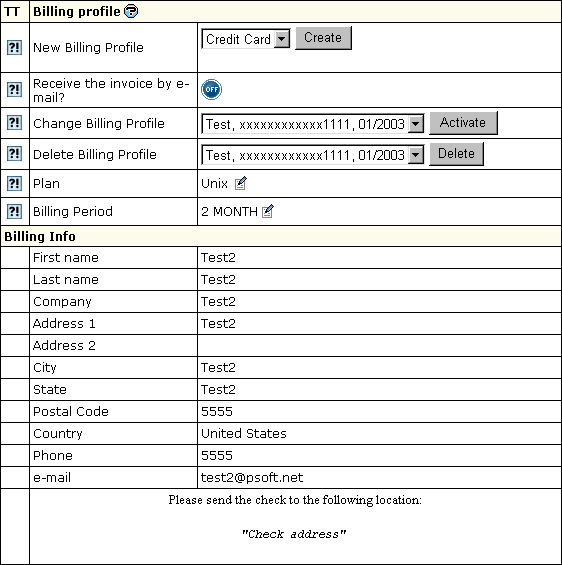
- New Billing Profile: Here you can create a new billing profile. After
you create it, it will become active.
- Receive invoices by e-mail?: Toggle the ON/OFF
button to receive/unsubscribe from invoice e-mails that inform you of:
- how much was accrued/charged for a) each paid operation, b) as recurrent
and usage fee when passing to a new billing period;
- your current balance status.
- Change Billing Profile: list of your inactive billing profiles. Select
the profile you want to set instead of the current one and press Activate.
* Information on your active profile is displayed in the lower Billing
Info section.
- Delete Billing Profile: list of your
inactive billing profiles. Select the profile you want to remove and press
Delete.
- Plan: the plan your account is registered under.
- Billing Period: Your plan may have various payment intervals. It
defines WHEN the system charges the fees. Each billing period may have different
set of discounts. A new billing period opens:
- when your account is activated after signup
- when your suspended account gets resumed
- when you switch to another plan
- when you change your billing period
A billing period closes:
- when you quit hosting
- when your account gets suspended
- when you switch to another plan
- when you change your billing period
|